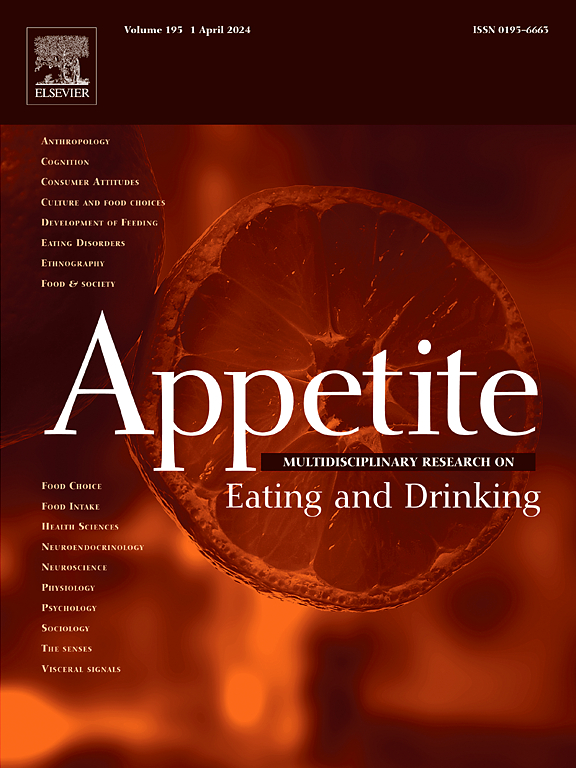眼见为实:包装正面的食品形象如何塑造父母对儿童休闲食品的看法。
IF 4.6
2区 医学
Q1 BEHAVIORAL SCIENCES
引用次数: 0
摘要
面向儿童的休闲食品通常会在包装前展示天然或健康的图像,但其中许多产品都是超加工的,营养不良。本研究调查了家长对儿童零食包装前食品形象的常见形式的看法。在线实验包括四种受试者之间的食物图像条件(无图像;食物的照片;食物卡通;儿童园艺卡通)和两个主题内小吃类型条件(水果;蔬菜)对N=800名4-10岁儿童的澳大利亚成年父母/监护人进行了研究。参与者观看了包装好的零食,然后对它们的视觉吸引力、健康程度、适合孩子的程度和购买意愿进行了评分。对于每个结果,进行了4(受试者间)x 2(受试者内)混合方差分析,使用Bonferroni调整的事后两两t检验探讨了显著的主效应。在何种程度上,感知指标预测购买意愿在每个条件下进行了检验,使用多元回归分析。参与者认为,与其他所有条件相比,展示食物照片的零食更健康。当儿童零食展示食物照片时,参与者认为这种零食更适合他们的孩子,并且比展示卡通儿童时表现出更强的购买意愿。在所有指标中,参与者都更喜欢水果而不是蔬菜零食,尤其是在照片逼真的情况下。视觉吸引力是唯一在不同条件下一致预测购买意愿的感知指标。研究结果提供了明确的证据,表明家长对儿童休闲食品的认知和购买意愿会因包装上的图片而增强。规范食品包装的政策应该要求包装上描绘的食品准确反映产品成分,特别是在代表全食品的情况下,实际成分经过高度加工,不再提供全食品的营养。本文章由计算机程序翻译,如有差异,请以英文原文为准。

Seeing is believing: How front-of-pack food imagery shapes parents’ perceptions of child-oriented snack foods
Child-oriented snack foods often display front-of-pack images suggesting they are natural or wholesome, yet many of these products are ultra-processed and nutrient poor. This study investigated parent's perceptions in response to common forms of front-of-pack food imagery on child-orientated snacks. An online experiment comprising four between-subjects food image conditions (no image; food photo; food cartoon; cartoon of children gardening) and two within-subjects snack type conditions (fruit; vegetable) was conducted with N = 800 Australian adult parents/guardians of children aged 4–10 years. Participants viewed packaged snacks then rated them on visual appeal, perceived healthfulness, suitability for their child, and purchase intentions. For each outcome, 4 (between-subjects) x 2 (within-subjects) mixed ANOVAs were performed, with significant main effects explored using post-hoc pairwise t-tests with Bonferroni adjustment. The extent to which perception metrics predicted purchase intention within each condition was examined using multiple regression analyses. Participants perceived snacks displaying food photographs as healthier compared to all other conditions. When children's snacks displayed food photos, participants perceived the snack as more suitable for their child and showed stronger intentions to purchase the product than when cartoon children were displayed. Participants preferred fruit over vegetable snacks across all metrics, particularly when the picture was photorealistic. Visual appeal was the only perception metric that consistently predicted purchase intention across conditions. Findings provide clear evidence that parent's perceptions and purchase intentions towards children's snack foods are enhanced by pictures displayed on the packaging. Policy to regulate food packaging should require that foods depicted on the packaging accurately reflect product ingredients, particularly where whole foods are represented, and the actual ingredients are highly processed and no longer provide the nutrition of whole foods.
求助全文
通过发布文献求助,成功后即可免费获取论文全文。
去求助
来源期刊

Appetite
医学-行为科学
CiteScore
9.10
自引率
11.10%
发文量
566
审稿时长
13.4 weeks
期刊介绍:
Appetite is an international research journal specializing in cultural, social, psychological, sensory and physiological influences on the selection and intake of foods and drinks. It covers normal and disordered eating and drinking and welcomes studies of both human and non-human animal behaviour toward food. Appetite publishes research reports, reviews and commentaries. Thematic special issues appear regularly. From time to time the journal carries abstracts from professional meetings. Submissions to Appetite are expected to be based primarily on observations directly related to the selection and intake of foods and drinks; papers that are primarily focused on topics such as nutrition or obesity will not be considered unless they specifically make a novel scientific contribution to the understanding of appetite in line with the journal's aims and scope.
 求助内容:
求助内容: 应助结果提醒方式:
应助结果提醒方式:


